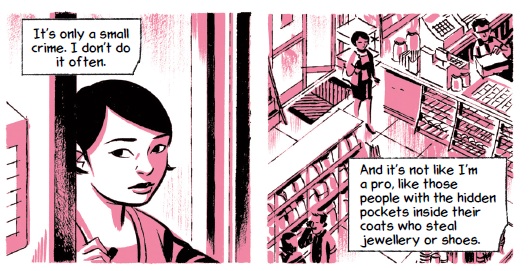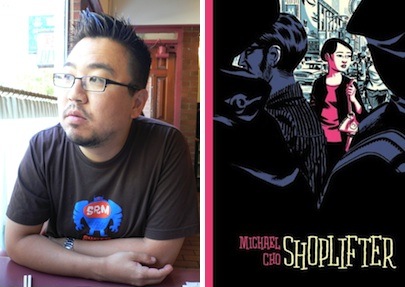Artist and illustrator Michael Cho has done covers for Marvel and DC, but this year he came to SDCC to talk about his new graphic novel Shoplifter, to be released by Pantheon in September. Shoplifter is the quiet, delicately-told story of Corinna Park, a writer in her mid-twenties who went from an English degree and dreams of writing novels to five years of writing copy at an advertising agency, a lonely apartment, and a terrible cat named Anais—with the occasional bit of (very) petty theft. Between panels, Cho took a moment to talk about the origins of Shoplifter, his comics process, and the difficulty of drawing bad-tempered cats.
Cho enjoys both genre comics and literary comics—“I grew up in the 80s where there was a big split between the two: there were people who did genre comics, and there were people who did literature. And as I grew up, I didn’t see a distinction. I wanted to see comics as a medium, not as a genre. And one of my favorite artists is David Mazzuchelli, who does both.” He’s also an admirer of the Hernandez brothers, Charles Burnes, and Daniel Clowes, as well as 1940s adventure comics—Milton Caniff’s Terry and the Pirates, Scorchy Smith by Frank Robbins, Noel Sickles, and Roy Crane. “Those are my favorite works of all time. I get a lot of my artistic approach, stylistically from those guys, because they did such an amazing job drawing anything, and art-style-wise, I learned a lot of my tricks from them.”
Cho has now turned his artistic style to a literary comic of his own. Shoplifter is the first of five graphic novels that Cho has been developing. After a period of working up to it, “working on shorter graphic novels, shorter comics stories,” Cho took a year off from his illustration work to write and draw Shoplifter. Starting with an outline, he developed a script, which he turned into a series of fully lettered (“in tiny tiny pencil”) thumbnails as a rough draft for the finished product. “I find that when I work on a graphic novel or any comics story, I put on my writing hat first, and then when that’s all complete, then I put on my artist hat. And usually they’re at war with each other. ‘Oh, the writer over-wrote this thing!’ or ‘you know what, this is a crazy scene; I didn’t realize when I wrote this that you can’t actually draw this thing.’”
Corinna’s story comes from Cho’s own experiences and those of his friends, “people who were very very talented and interesting, very intelligent, very sharp wits… but for some reason were unable to create.” He was interested in that stage of one’s middle twenties, when “you’re really well-trained and well-educated but you feel like you’re drifting, because the school structure is now over and you have to actually go out and pursue your own goals.” Corinna herself is a composite of various people; like Cho, she’s Korean-Canadian. “She’s like someone I know, and I wanted to write a story like that.”
Corinna is drifting, uneasy with other people and slow to make friends, and her chief companion is a grouchy cat named Anais, who isn’t particularly grateful for having been taken in to where she can be fed regularly. Cho sees the cat as a reflection of Corinna; the cat resents her caretaker as Corinna resents the corporate world to which she owes her security. Cho found the cat difficult to draw; his five-year-old daughter, on learning of this problem, “came back from the library with a bunch of books and one of them was, some Disney books, a Frozen book, and then she goes, ‘Look, Daddy, I took this out for you! How to Draw Cats!’”

Stifled creatively and frustrated with her job and her housecat, Corinna’s only outlet for her frustration—“an impotent rebellion”—is shoplifting magazines. “She thinks it’s a victimless crime because she thinks she’s only hitting large chain stores that are franchises, that are corporate, so she makes a point not to shoplift from little mom and pop stores, and she only steals magazines […] she views it as something of a little outlet, as her own personal little rebellion against the monolithic, consumerist and corporate culture,” Cho said. “She only does it when she feels particularly constrained by her job, and the demands of working in an advertising agency, and it’s her way of being an outsider.”
Corinna’s story may seem depressing and dead-ended, but it ends on a gentle note of hope for her future. “Corinna Park is someone who, throughout the course of her story, discovers the value of being herself rather than projecting an image of herself,” Cho said. “Part of the subtext of the story is the images of ourselves that we project. We sell ourselves on social media, try to project this life that we’re living.”
Having spent the last year developing this story of quiet moments, Cho doesn’t rule out the possibility of returning to genre comics—genre comics were his first love in the medium, after all, and he sees no reason why he can’t do both: “Every once in a while I write a very depressing story […] in the middle of it, when I’m talking to my wife, I just tell her ‘when this is over, I’m going to draw an action adventure thing with car chases.’ And I like being able to fly between the two. I want to be good at both things and express whatever my artistic muse leads me to.”
Karin Kross is on her way back from her sixth San Diego Comic-Con. She can be found elsewhere on Tumblr and Twitter, and she, her husband Bruce, and her friends Shellie and John are posting about SDCC at nerdpromnomnom.










